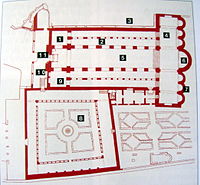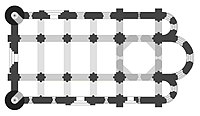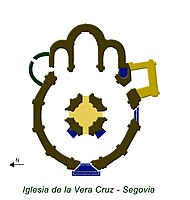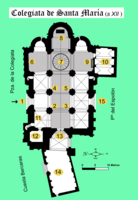Spanish Romanesque: Difference between revisions
m Removed invisible unicode characters + other fixes, removed: (2) using AWB (11386) |
No edit summary |
||
| Line 10: | Line 10: | ||
== Architecture == |
== Architecture == |
||
[[File:Iglesia de Santa Maria de Eunate.jpg|thumb|left|[[Santa María de Eunate]].]] |
[[File:Iglesia de Santa Maria de Eunate.jpg|thumb|left|[[Santa María de Eunate|Eunateko Andre Maria]].]] |
||
[[File:SanIsidoroLeóninterior.jpg|thumb|Lateral nave (with edge vaults) and central nave (barrel vault) of the church of San Isidoro de León (left, startup of lobed arch of transept).]] |
[[File:SanIsidoroLeóninterior.jpg|thumb|Lateral nave (with edge vaults) and central nave (barrel vault) of the church of San Isidoro de León (left, startup of lobed arch of transept).]] |
||
| Line 29: | Line 29: | ||
File:Lisbon cathedral annotated map.svg|[[Lisbon Cathedral|Cathedral of Lisbon]]. |
File:Lisbon cathedral annotated map.svg|[[Lisbon Cathedral|Cathedral of Lisbon]]. |
||
</gallery></center> |
</gallery></center> |
||
==Sculpture== |
|||
{{Commons|Category:Romanesque sculptures in Spain|Romanesque sculptures in Spain}} |
|||
[[File:Carrión de los Condes, iglesia de Santa María del Camino-PM 34901.jpg|thumb|left|Carrión de los Condes.]] |
|||
[[File:Santandreusureda1.jpg|thumb|San Andrés de Sureda.]] |
|||
[[File:Noia 060828 061.JPG|thumb|Facade of [[San Martiño (Noia)]] {{commons|Category:Romanesque portal sculptures in Spain}}.]] |
|||
[[File:Avila - Basilica de San Vicente, exteriores 12.jpg|thumb|left|West facade of San Vicente (Ávila).]] |
|||
[[File:Eunate - Ermita de Santa Maria 20.jpg|thumb|[[Church of Saint Mary of Eunate|Eunateko Andre Maria]] {{commons|Category:Romanesque statues of Madonna and Child in Spain}}.]] |
|||
[[File:Detalle de un capitel del claustro del Monasterio de San Juan de la Penna.jpg|thumb|left|Cloister of [[San Juan de la Peña|Monastery of Sant Chuan d'a Penya]].]] |
|||
The earliest works of the [[Romanesque sculpture]] in the Hispanic-Christian peninsular kingdoms are two beam of the Roussillon area [[Saint-Génis-des-Fontaines]] (dated in 1020)<ref>[http://www.artehistoria.jcyl.es/v2/obras/19878.htm Ficha en Artehistoria]</ref> and [[Monastery of Sant Andreu de Sureda|Sant Andreu de Sureda]] (which plays its forms). Also from 11th century are the tympanum of the [[Cathedral of Jaca]], the gables of [[Basilica of San Isidoro|San Isidoro (León)]], the Facade of Pratarías of [[Cathedral of Santiago de Compostela]] (the [[Master Esteban]]), the cloister of [[Abbey of Santo Domingo de Silos|Santo Domingo de Silos]]. In the 12th century emphasizes the facades of [[Santa Maria de Ripoll]], the of [[Church of Santa María la Real|Andre Maria erreginaren eliza]] (Zangoza/Sangüesa) of the [[Abbey of San Pedro el Viejo|Sant Per o Viello]] (Huesca) and the cloister of [[San Juan de la Peña|Monastery of Sant Chuan d'a Penya]]. In the late 12th century belong the facades of the [[Church of Santa María del Camino (Carrión de los Condes)]] and [[Santo Domingo, Soria|Santo Domingo (Soria)]]. In some works of this period is visible the transition to [[Gothic sculpture|Gothic]]: the apostolate of the [[Cámara Santa|Cámara Santa (Oviedo)]], the facade of [[San Vicente, Ávila|San Vicente (Ávila)]] and [[Portico of Glory|Portico of Glory]] of Cathedral of Santiago de Cosmpostela (of [[Master Mateo]]).<ref>Juan Haro, op. cit.; Raquel Gallego, ''op. cit.'', pg. 189 y ss.</ref> Another of the early sculptors of known name is [[Arnau Cadell]] (capitals of the cloister of [[Monastery of Sant Cugat|Sant Cugat]]). |
|||
[[File:Pórtico de la Gloria (66231651).jpg|thumb|center|400px|Portico of Glory.]] |
|||
The carvings in the round bulge that have been preserved, in polychrome wood, usually have as theme the [[Christ crucified]] in the type called ''[[Majesty (crucifix)|Majesty]]'' and the [[Madonna with Child]] in the type called ''[[Seat of Wisdom|sedes sapientiae]]'' ("Seat of Wisdom"). An exceptional sculpture complex is the ''[[Davallament of Sant Joan de les Abadesses]]'', of transition to the Gothic.<ref>Raquel Gallego, ''op. cit'', pg. 192.</ref> |
|||
[[File:Monestir de Sant Joan de les Abadesses-PM 24970.jpg||thumb|center|300px|Davallament of Sant Joan de les Abadesses]] |
|||
==References== |
==References== |
||
Revision as of 04:47, 24 August 2015


Spanish Romanesque to designate the spatial division of the Romanesque art corresponding to Hispanic-Christian kingdoms of the Iberian Peninsula in the 11th and 12th centuries. However, its stylistic features are essentially common to the European Romanesque, and in the particular differentiated between areas that usually subdivided. The southern half of the peninsula lacks of Romanesque art since remained under Muslim rule (Andalusi art). The Romanesque in the central area of the peninsula is low and late, with virtually no presence at south of the Ebro and the Tagus; It is the northern third peninsular the area where are concentrated the Romanesque buildings. In view of the fact that the Romanesque is introduced into the peninsula from east to west, for the purposes of its study, the regional delimitation is done in the same direction: in "eastern kingdoms" (the kingdoms or Pyrenean areas: Catalan Romanesque, Aragonese Romanesque and Navarrese Romanesque), and "western kingdoms" (Castilian-Leonese Romanesque, Asturian Romanesque, Galician Romanesque and Portuguese Romanesque).
The First Romanesque or Lombard Romanesque has especially presence in Catalonia, while the full Romanesque spread from the foundations of the Order of Cluny along the axis of Camino de Santiago. The late-romanesque continues in the 13th century, especially in rural buildings.[1]
Architecture


From the 11th century the European artistic influence (especially Burgundian - Cluny - and Lombard monasteries - Lombard archs -) was superimposed on local artistic traditions ( called as "Pre-Romanesque - Visigothic art, Asturian art, Mozarabic art or Repoblación art) and Andalusi art or Hispanic muslim) and lived with the so-called Mudéjar Romanesque (or "Romanesque of brick", dominant in some areas, such as the center of the Northern Plateau -from Sahagún to Cuéllar-, Toledo or Teruel) giving rise to an art of strong personality.
The chronology in the penetration of architectural forms is visible in a display from east to west, being the first examples in Catalonia (Sant Pere de Rodes, 1022) and developed around Camino de Santiago those of Aragon (Cathedral of Jaca, from 1054), Navarre (Leire, 1057), Castile (San Martin de Frómista, 1066) and Leon (San Isidoro -portico of 1067), ending in Galicia, where it raised the most outstanding work: the cathedral of Santiago de Compostela (begun in 1075 with the plant of pilgrimage characteristic of most of the churches of the Way, from that of St. Sernin of Toulouse). The 12th century was the culmination of the style (Monastery of Ripoll, churches of Boí and Taüll -in Catalonia-, Castle of Lobarre, Monastery of Sant Chuan d'a Penya -in Aragon, Palace of the Kings of Navarre (Estella), Done Mikel eliza (Estella-Lizarra), Saint Mary of Eunate, Saint Peter of Olite -in Navarre-, Segovian arcaded churches, Santo Domingo (Soria), San Juan de Duero -in Castile-, Cathedral of Zamora, Old Cathedral of Salamanca -in Leon-). From the late 12th is identified the transition from Romanesque to Gothic (Cathedral of Tarragona, La Seu Vella (Lleida)).[2]
Few, but notable are the churches of central plant, which are often associated with models of the Holy Land brought by the military orders (Eunate in Navarre, Vera Cruz in Segovia).[3]
Gellery
Sculpture








The earliest works of the Romanesque sculpture in the Hispanic-Christian peninsular kingdoms are two beam of the Roussillon area Saint-Génis-des-Fontaines (dated in 1020)[4] and Sant Andreu de Sureda (which plays its forms). Also from 11th century are the tympanum of the Cathedral of Jaca, the gables of San Isidoro (León), the Facade of Pratarías of Cathedral of Santiago de Compostela (the Master Esteban), the cloister of Santo Domingo de Silos. In the 12th century emphasizes the facades of Santa Maria de Ripoll, the of Andre Maria erreginaren eliza (Zangoza/Sangüesa) of the Sant Per o Viello (Huesca) and the cloister of Monastery of Sant Chuan d'a Penya. In the late 12th century belong the facades of the Church of Santa María del Camino (Carrión de los Condes) and Santo Domingo (Soria). In some works of this period is visible the transition to Gothic: the apostolate of the Cámara Santa (Oviedo), the facade of San Vicente (Ávila) and Portico of Glory of Cathedral of Santiago de Cosmpostela (of Master Mateo).[5] Another of the early sculptors of known name is Arnau Cadell (capitals of the cloister of Sant Cugat).

The carvings in the round bulge that have been preserved, in polychrome wood, usually have as theme the Christ crucified in the type called Majesty and the Madonna with Child in the type called sedes sapientiae ("Seat of Wisdom"). An exceptional sculpture complex is the Davallament of Sant Joan de les Abadesses, of transition to the Gothic.[6]

References
- ^ Antonio Fernández, Emilio Barnechea and Juan Haro, History of Art, Barcelona: Vicens-Vives, 1992, ISBN 9788431625542, cp. 9, pg. 145-165.
- ^ Juan Haro, op. cit.
- ^ Raquel Gallego, Historia del Arte, Editex, 2009, pg. 188
- ^ Ficha en Artehistoria
- ^ Juan Haro, op. cit.; Raquel Gallego, op. cit., pg. 189 y ss.
- ^ Raquel Gallego, op. cit, pg. 192.






